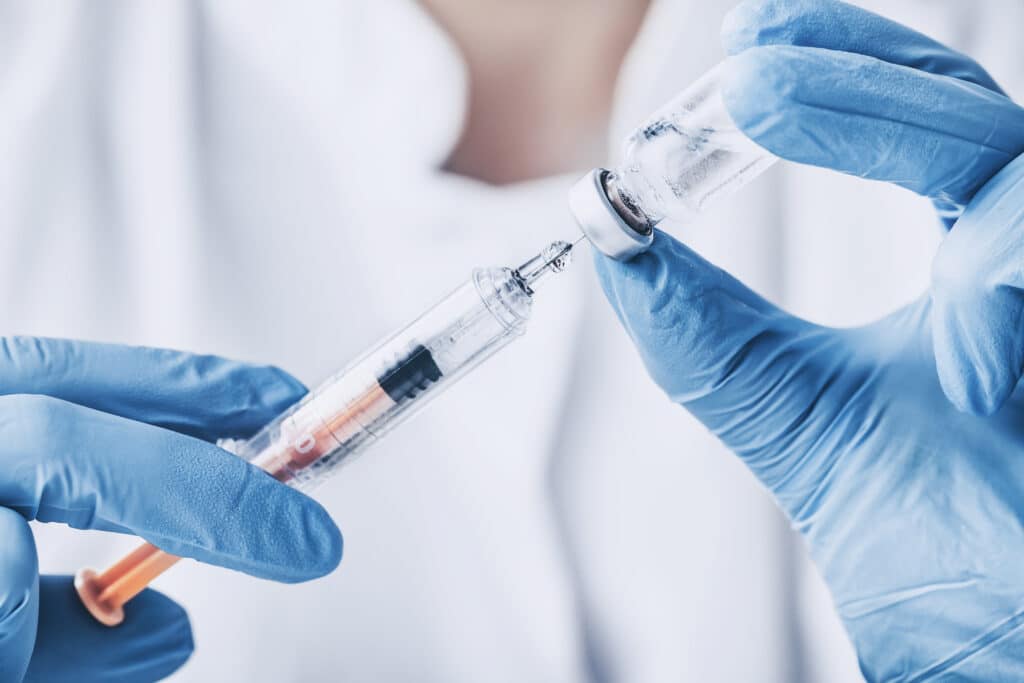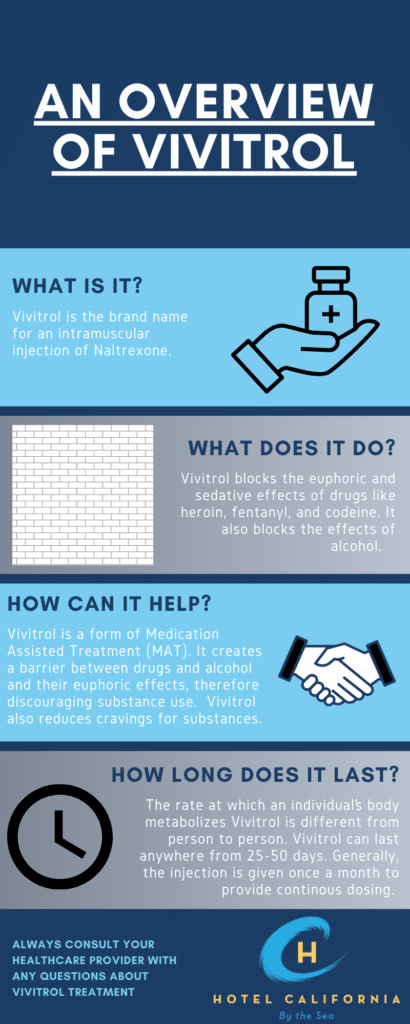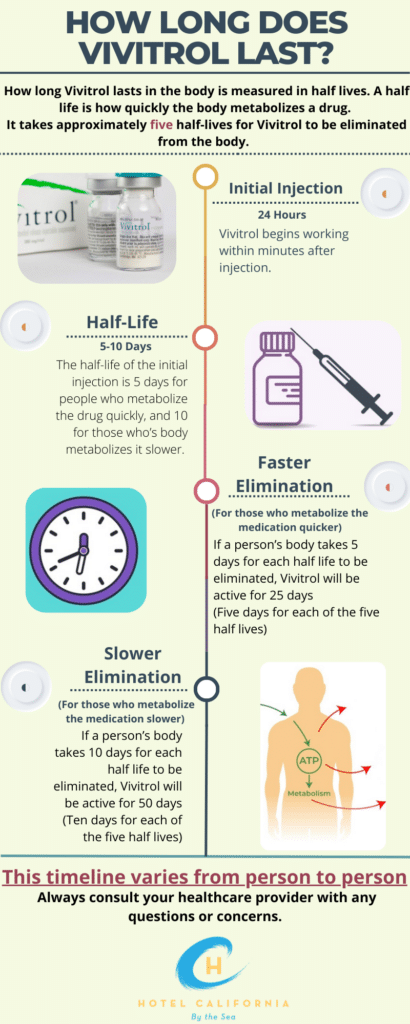How long does Vivitrol last?
The opioid epidemic has been making waves across the U.S. for some time now. In its current state, researchers are finding that fentanyl in combination with other drugs like heroin has become increasingly popular and could set off another wave of opioid-related overdose, addiction and deaths. Vivitrol, a naltrexone drug that is intramuscularly injected, is one solution in helping to combat the fight against opioids. Vivitrol is an opiate antagonist used in the treatment of opioid use disorder. This extended-release injection medication was approved by the FDA to treat both opioid use disorders as well as alcohol use disorders.

Vivitrol contains the active ingredient naltrexone. It comes in both an oral tablet and in an injectable form, the latter being the most common form of administration. For the treatment of alcohol use disorder, the daily oral tablet is the most common form of administration. For the treatment of opioid use disorder, a monthly injection is the most common form of administration.
In 1984, the FDA approved naltrexone as a prescription medication used in medication-assisted treatments (MAT) for substance addiction. Medication-assisted treatment is the use of medications in combination with counseling and behavioral therapies for the treatment of alcohol and substance use disorders. Together, both medical and behavioral therapies are clinically proven to be effective treatments in helping clients overcome addiction and sustain recovery.
How does Vivitrol work?
Naltrexone works by blocking the effects of opioid receptors and decreases cravings to use opioids and alcohol. When naltrexone enters the body, it will bind to various opiate receptors such as mu, k and gamma receptors. These receptors are often responsible for endorphin release. By blocking these receptors that produce hormones like dopamine, it will signal to the brain to produce more endorphins to relieve pain.
Dopamine is a chemical that the body produces naturally, that helps create pleasant feelings and sends signals to the body to continue drinking alcohol or using opioids. The drug blocks the sites in the body where alcohol attaches and stops dopamine from being released. This helps with fewer cravings and deters users from continuing to drink and continue to use opioids.

When naltrexone binds to the receptors trying to produce pain relief, typical opioid responses such as feelings of intense relaxation, respiratory depression, drug cravings and euphoria are blocked or dulled. This ultimately deters the users from developing a tolerance, dependence and addiction to opioids. For those who suffer from alcohol dependence, the drug blocks the effects and feelings associated with alcohol use. It helps reduce cravings, and how much alcohol is consumed and can help users maintain alcohol sobriety.
Vivitrol is not an opioid. It is not an addictive substance and does not cause users to experience withdrawal symptoms once the medication has been stopped. Ultimately, the prescription medication makes returning to alcohol or opioid use less intoxicating. It lessens the desired effects usually accompanied when using the substances.
How long does Vivitrol last?
Naltrexone has a half-life of about 13 hours after initial oral administration. The half-life of a drug refers to the amount of time in which the active drug has reduced by half in the body. During treatment using oral administration, medication must be taken daily in order to be effective. The half-life of a Vivitrol injection is around 5-10 days. This is because the Vivitrol injection provides an extended release of medication into the system that can last for months.
How long Vivitrol can last within your system is ultimately dependent on each individual and various factors. These factors include individual physical and health conditions, metabolism, body mass index and genetic variations.

Naltrexone can be detected in the blood for about 24 hours after the initial dose. Traces of the medication can remain present in the blood for as long as 3-4 days and even up to a month after.
- A urine test can detect naltrexone within 4-6 hours and up to months after
- A blood test can detect naltrexone within 24 hours and up to months after
- A saliva test can detect naltrexone within 24 hours and up to months after
- A hair test can detect naltrexone within 90 days
Naltrexone for treating Alcohol Use Disorder and Opioid Use Disorder
This prescription medication is often used in the treatment of alcohol use disorder (AUD) and opioid use disorder (OUD). The following are signs that a person may be experiencing alcohol use disorder or an opioid use disorder.
- Unable to quit using the drug despite continued problems with medical health and personal relationships
- Requiring the use of more alcohol and opioids in order to achieve the same desired effects
- Spending the majority of time finding, using and recovering from alcohol and drug use
- Have the desire but the inability to decrease the amount of alcohol or opioids used
- Giving up on activities and hobbies once loved
Vivitrol for Opioid Use Disorder
Vivitrol is often used as medication management for treating opioid use disorder. Patients in treatment for OUD must stop opioid use for at least 7-14 days prior to starting Vivitrol treatments. If there are still opioids in the system upon treatment, patients are prone to experiencing intense withdrawal symptoms such as sweating, shaking, nausea and vomiting. On rare occasions, patients using opioids while on Vivitrol can experience opioid overdose.
Vivitrol is a narcotic blocker and opioid antagonist. Monthly injections after withdrawal help users maintain control over their cravings for opioids.
Naltrexone for Alcohol Use Disorder
When naltrexone is used for the treatment of alcohol use disorder, it helps to reduce cravings for alcohol, reduce the quantity of alcohol consumed and reduce the reward effects produced by alcohol. Often taken as a daily dose, naltrexone reduces a patient’s desire to continue drinking and helps users continue abstinence from alcohol.
Naltrexone is a prescription medication and can only be administered under the care of an addiction medical specialist. The medication works by modifying the hypothalamic pituitary adrenal axis to suppress ethanol consumption. This ultimately decreases alcohol consumption because users no longer receive the rewarding effects they once desired from drinking. Treatment for alcohol use disorder while under naltrexone lasts an average of 3-4 months.
Check Your Insurance Coverage for FREE
Find out if your insurance covers addiction treatment in minutes. We accept most insurance!
Symptoms and Side Effects of Vivitrol
Like any drug, Vivitrol has its own set of side effects. However, addiction experts and medical professionals alike agree that the medication can drastically improve the outcome of addiction treatment and the benefits outweigh any potential side effects.
- Nausea
- Headache and dizziness
- Tried and fatigue
- Decreased appetite
- Liver damage
- Pneumonia
- Sudden opioid withdrawal
- Suicidal thoughts and behaviors
- Anxiety
- Joint and muscle pain
- Abdominal pain
- Depression – feelings of hopelessness, sadness, losing interest in things you once loved, sleeping more than usual and angry and aggressive behaviors
Vivitrol vs other common medications used to treat OUD
Methadone is a medication that works as an opioid agonist. It activates receptors in the brain to alter how the brain responds to pain. When it was first introduced as a treatment in the 1970s, it became the primary medication used to assist in managing opioid use disorder.
Later on, when the drug Suboxone was created, the combination of buprenorphine and naloxone showed clinical evidence that also helped to treat symptoms of opioid use disorder. Suboxone is a partial opioid agonist that activates the opioid receptors in the brain but at a limited capacity. It was shown to be effective in decreasing cravings and reducing the risk of relapse and overdose.
Both medications are FDA-approved for use in medication-assisted treatments. Methadone and Suboxone work by activating opioid receptors to help suppress cravings. On the other hand, Vivitrol works by completely blocking the receptors to reduce cravings. All three medications are clinically proven to help treat symptoms of and help with long-term management of opioid abuse.
Reach out to Hotel California by the Sea
We specialize in treating addiction and other co-occurring disorders, such as PTSD. Our Admissions specialists are available to walk you through the best options for treating your addiction.
Hotel California by the Sea provides effective substance use disorder treatment for clients misusing prescription medications such as opioids. The best way to overcome an addiction is through a professional addiction treatment center that offers varying levels of care. These levels of care include substance detox, residential program, partial hospitalization program and intensive outpatient program. Clients will receive individualized treatments that cater to their needs throughout each level of care.
Hotel California by the Sea believes there is no one-size-fits-all when it comes to addiction treatment. Each client has his or her own set of obstacles to overcome. Through unique treatments such as CBT, EMDR therapy and family therapy, clients will receive a comprehensive treatment plan. This plan can consist of medication therapy as well as behavioral therapy. When addressing every aspect of addiction including physical, emotional and psychological, clients have a higher chance of long-term recovery.
References:
https://addictionresource.com/drugs/naltrexone/stays-in-system/
https://www.healthline.com/health/drugs/vivitrol#what-it-is
https://psychiatry.uams.edu/clinical-care/cast/what-is-naltrexone/
https://www.ncbi.nlm.nih.gov/books/NBK534811/
https://www.addictioncenter.com/alcohol/naltrexone-for-alcoholism-treatment/
https://adf.org.au/drug-facts/naltrexone/
https://www.hazeldenbettyford.org/articles/methadone-vs-suboxone-opioid-treatment
https://www.bicyclehealth.com/opioid-education/how-long-does-naltrexone-take-to-work
